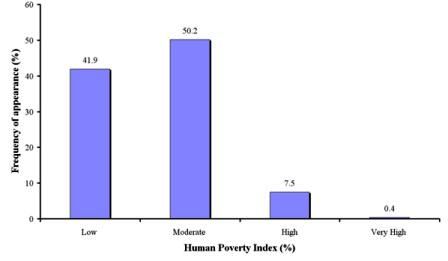Human poverty index
As it is defined by the UNDP (United Nations Development Programme), Human Poverty Index is a compound index, based on a number of component measures that calculates a summary statistic on the economic welfare of the poor in a society. Since poverty is a multidimensional issue and a relative concept, therefore different factors and different expectations need to be taken into account in different countries. The HPI-2 indices developed by the UNDP have been used for the DESIRE project. HPI-2 has been based on four component measures of deprivation, each of which need to be defined:
- Longevity: the percentage of the population with a life expectancy of less than 60 years.
- Illiteracy: the percentage of the population aged 15 years or over who are unable, with understanding, both to read and write a short, simple statement on their everyday life.
- Standard of living: the percentage of the population living below the poverty line (defined as 50% of the median disposable personal income).
- Exclusion: percentage of the work force in long-term unemployment (12 months or more).
These four components have been computed using the following equation:
HPI-2 = [0.25(P23+P43+P53+P63)] 0.33
Where: P2 = illiteracy rate for the people aged 15 years of older
P4 = percentage of people not expected to survive more that 60 years
P5 = percentage of people with disposable income < 50% of the median income
P6 = percentage of people in long term unemployment.
The following classes have been defined: (a) low- HPI-2 <10, (b) moderate- HPI-2 = 10-20, (c) high- HPI-2 = 20-50, and (d) very high- HPI-2 >50. The necessary data for calculating poverty index have been collected from the National Statistical Service of the study sites.
As Table 14 shows, data for this indicator have been collected for 217 field sites, corresponding to 5 study sites. The analysis of the data have shown moderate is the dominant class of human poverty index, covering 50.2% of the study field sites (Fig. 94). Such class of poverty index has been defined for all study field sites of Djanybek-Russia, Gois-Portugal, and Konya Karapinar plain-Turkey study sites. Low human poverty index is the next important class, covering 41.9% of the study field sites, and corresponding to all field sites of Novij Saratov-Russia, Cointzio Catchment-Mexico, and Mação-Portugal. High poverty index has been defined in 7.5% of the study field sites, corresponding to the some of the field sites of Boteti Area-Botswana. Finally, in few field sites of Boteti have been described as subjected to very high human poverty index (Fig. 94).

Fig. 94. Distribution of human poverty index classes defined in the study field sites